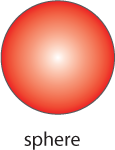Sponge sections
You have been given three shapes made out of sponge: a sphere, a cylinder and a cone. Your challenge is to find out how to cut them to make different shapes for printing.
Problem
You have been given three shapes made out of sponge: a sphere, a cylinder and a cone.



You are going to make some shapes for printing out of these sponges.
How would you cut the sphere to make the largest circle for printing?
How could you make the largest possible circle from the cylinder ... and the cone?
Which shape would you use to make a very small circle for printing?
If you cut the shapes in different ways, what other shapes for printing could you make?
If you make two cuts, are other shapes possible?
Getting Started
Use some modelling clay to make the shapes yourself and try it out.
For the sphere, you could imagine you were cutting an apple or orange.
It might help to have a good look at each shape before you make any cuts!
Student Solutions
Alex from Cutthorpe Primary School and Lucy from Caversham Primary sent in very clear solutions to this problem. Alex says:
To make a large circle from the cylinder and cone just use the flat faces of these shapes.
Lucy adds:
You would cut the sphere in the exact centre to get the largest possible circle from the sphere (the cut would have to be in the absolute exact centre).
She goes on to say:
You would use the cone to make a very small circle for printing. You would cut it at the top of the point.
If you cut the cone straight down from the point, you would find that the face would now be a semi-circle and the new face would be a type of triangle.
If you cut the cylinder down from the face you would find that the face was a semi-circle and the new face would be a rectangle.
If you cut the sphere in any place the face would still be a circle.
With two cuts, Alex suggests that you could cut the rectangle you made earlier (from the cylinder) into a square.
Naomi, who is Home Educated, suggests that you could make the biggest possible circle by rolling the cone around on its side, keeping the vertex as the centre of the circle. What a great idea.
Thank you also to A from MLC in Australia who sent a full solution. (He/she didn't give us a full name.)
Are there any other possibilities? Let us know if you find any.
Teachers' Resources
Why do this problem?
Possible approach
Key questions
Possible extension
Learners could go on to find different plane shapes in other solids such as a cube, tetrahedron and various pyramids.
Possible support
Having some ready-made clay models of the shapes will support those children who want to try out different cuts but find it hard to create the shapes from scratch. You may need to emphasise that, before they make any cuts, learners must have convinced at least one other person that their cut will produce the desired effect.
